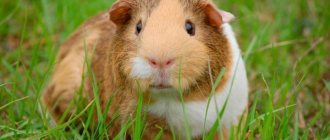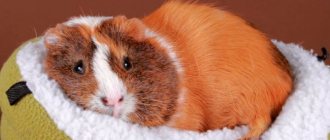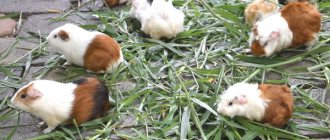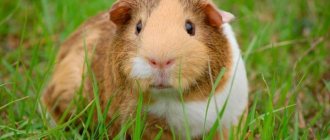Guinea pigs usually behave calmly and evenly, but sometimes their behavior deviates from the usual. They may begin to behave inappropriately and in a frightening manner: jumping, continuously running around the cage, twitching, etc. There is no single answer to why a pet loses self-control and begins to behave so strangely. Such manifestations can be caused by various reasons.
Sleep disturbance and hiccups
Guinea pigs are very active animals. They sleep several times a day and little by little, and in case of danger or in an alarming situation, the guinea pig sleeps with its eyes open. Young animals spend less time sleeping, but older animals spend much more time sleeping. If your guinea pig lives alone, it may also sleep longer. Sleep disturbances are usually caused by a nervous state, problems with skin parasites and improper feeding. You can identify problems with sleep in an animal by changing behavior - the guinea pig becomes more active, loses appetite, may show aggression and refuse offered treats. It is not the effect that should be treated, but the cause - examine the animal, donate blood for analysis and scrape the skin to identify skin parasites.
Sleep problems sometimes cause your guinea pig to hiccup.
Another cause of hiccups is a cold. Signs of a cold include lethargy, decreased appetite, elevated body temperature and heavy breathing. Purulent and mucous discharge is possible from the eyes and nose. Colds are treated with Sulfazine or Sulfadimezine 0.1 mg per kilogram of guinea pig weight three times a day.
Allergies also cause hiccups. Allergies are most often caused by dust contained in sawdust or hay, or too sweet or sour foods. In addition to allergies, problems with clean drinking water can also cause hiccups. The daily amount of water consumed by a pig is approximately 100 ml. However, if yesterday a guinea pig drank more than normal, and today it hardly comes to the drinking bowl, this is not a sign of concern. Sometimes the difference in water consumption can be explained by changes in weather and temperature, changes in mood and the abundance of succulent food in the feeder. But if the animal is thirsty and the drinking bowl is empty, then hiccups may occur.
Reasons for crazy racing
As you try to figure out why your pet jumps up and down while performing exciting tricks, consider recent events that pleased your pig:
- receiving treats or a new portion of hay with a fragrant smell;
- the opportunity to walk outside the usual conditions and other amenities depending on the characteristics of a particular animal.
If none of the above actions have been performed, then think about the convenience of keeping a pet. A cramped room, deprived of additional space for play, literally puts pressure on the animal, depriving it of the opportunity to stretch its legs. Over time, lack of activity leads to running in one place.
Try changing the usual house for a larger living space containing tunnels, a wheel and other toys.
Injuries
If your guinea pig falls on the floor or the soft surface of a chair or sofa, it can cause injury. The animal should be examined immediately for bleeding, lameness, or swelling of the legs. Sometimes it takes a few minutes for the animal to realize that there is a problem, so the breeder should watch the guinea pig for a while. If an animal falls from a height (escapes from the hands and falls to the floor), this can lead to broken limbs. Sometimes the fall ends more sadly: the guinea pig's hind legs give out or it cannot lean on its front legs. This indicates a spinal fracture. The animal must be taken to a veterinarian immediately and x-rayed.
If after the fall the pig does not limp, but slight swelling appears, it is removed with injections:
- Cerebrolysin,
- Mexidol,
- Prednisone.
The drugs are administered 0.1 ml per kilogram of the animal’s weight intramuscularly for a week. In addition to medications, it is necessary to massage the injured limbs.
Return to the cage
Another common reason for guinea pigs to jump is when returning to their home. Sometimes they begin to jump for joy even before they get into their home cage, that is, in the hands of the owner. It happens that the pig jumps from the owner's arms. Some owners not only do not interfere with this, but even encourage the impulses of the “sports” pet. But with such jumps, a pet can easily harm itself, get injured or bruised.
To prevent this, it is important to wean your pet from such tricks. To do this, you need to firmly but carefully grab the animal with your hands and place it in such a “trap” inside the cage. The pig should be kept at a height of several centimeters from the bottom. It is important not to unclench your hands until the pet calms down. Then the animal is placed on the floor of the cage, but is not completely released until it stops twitching and struggling. When the pig finally calms down, you can give her freedom. If necessary, the lesson is repeated.
Eye diseases
One of the most common diseases is conjunctivitis. Conjunctivitis in guinea pigs is caused by infection, chemical irritants and physical injury. The disease can affect one eye or both at once. The disease has three stages, each of which has its own symptoms:
- First stage. Swelling, redness of the eyes, sticking of eyelashes,
- Second phase. Discharge of pus from the eyes, the eyes stop opening,
- Third stage. Clouding of the cornea and loss of vision.
If a guinea pig gets sick with conjunctivitis, then first aid will be provided by Albucid solution, which removes mucous and purulent discharge from the eyes. After the eyes have been washed, it is necessary to put Tetracycline or Hydrocortisone ointment under the eyelid. The area around the eyes should also be lubricated with the same ointment. If clouding of the cornea is observed, Calomel should be injected into the affected eye, after mixing it in equal proportions with powdered sugar. The procedure is repeated twice a day.
Eye diseases also include keratitis. It causes a violation of the integrity of the cornea of the eye, and the cause is damage to the mucous membrane by prickly grass or twigs. Keratitis is treated with Fluorescein solution and eye drops. Additionally, you can use any glucose-containing eye ointment.
What is popcorning
Many inexperienced pig owners wonder why the big tooth suddenly starts jumping, twitching, skipping and running around its home. There is no need to be afraid, most likely this is the so-called popcorning, a natural and harmless phenomenon. Your pet is just having fun, so he runs around the cage, showing joy as best he can. The term itself comes from the word "popcorn", when the corn is cooked, it shoots and flies in different directions, this is very similar to the behavior of a guinea pig when it is happy.
As a rule, this condition is typical for young animals, but quite adult pets can express joy in this way. The guinea pig is a sociable and companionable pet. Ideally, you should get several animals at once, this will make it easier for them to adapt to a new cage and strangers. If you have one animal, then you need to devote as much time as possible to it and know all the nuances of the furry’s behavior.
Important! This phenomenon is contagious; if one pig starts to “go crazy”, then soon all the rodents living in the house will be running around the cage or jumping in place.
As a rule, this condition is typical for young animals, but quite adult pets can express joy in this way.
The reasons may be different:
- fed with your favorite food;
- returned to the cage after being held;
- natural joy caused by good health.
But sometimes such behavior can be caused by negative reasons, so you need to very carefully monitor the condition of the fluffy.
Important! This phenomenon is contagious; if one pig starts to “go crazy”, then soon all the rodents living in the house will be running around the cage or jumping in place.
The joy of returning to the cage
These animals are very calm and non-conflict creatures. They, unlike scratching cats and biting dogs, do not strive to stand up for themselves. In the wild, pigs run away from the enemy and hide in hard-to-reach places. Therefore, when you take your pet in your arms, despite the fact that outwardly he is completely calm, he is actually very scared. The subsequent return to the rodent's cage means the restoration of conditions in which it feels comfortable or protected. Naturally, the animal will show joy in every possible way - jumping, running and twitching in different directions.
Other reasons
The reasons why your pet exhibits popcorn behavior can be different. Experienced breeders summarize them in two words - natural joy. Perhaps the rodent was fed its favorite nuts or zucchini. He can wake up and feel good because his stomach has stopped hurting, etc. Any individual pig will have its own reason for joy, the main thing for its owner is not to worry, but to take a close look at the fluffy to understand what it is the condition is caused.
Did you know? Pigs are divided into three main types: English or American - with short fur, Peruvian - with a straight, silky coat, and Abyssinian - with dense fur, decorated with small funnels.
Kidney diseases
Kidney stones are a fairly common condition in guinea pigs. And the first symptom is frequent urination. Treatment of urolithiasis is impossible without surgery. Another kidney disease is crystalluria. It is provoked by the peculiarity of the guinea pig's metabolism, when calcium is washed out of the body by urine. When the disease occurs, the urine turns white and becomes very cloudy.
Changes in the color of urine in a guinea pig can be caused not only by diseases, but also by changes in diet.
Some vegetables and fruits contain coloring pigments that can turn urine pinkish or dark yellow. Individual droplets of blood contained in the urine should cause alarm. If blood is noticed in the urine, the animal must be taken to a veterinarian to determine the exact cause. This could be an infection in the urinary canal or in the uterus, stones or sand in the bladder, or a problem with the intestines.
You should consult a doctor immediately if you notice the following symptoms:
- The appearance of mucus in the urine,
- The pig stopped urinating
- The animal's urine smells like silt,
- The pig urinates frequently and little by little.
Constant thirst is also a dangerous symptom. If the feeding diet has not changed, and the animal drinks a lot, then you should also consult a doctor.
Self-treatment of these diseases at home can lead to serious complications and death of the animal.
How does it manifest?
Popcorn attacks can cause fear and panic in an inexperienced owner. At these moments the animals:
- quickly run in circles;
- jump and twitch while jumping;
- they squeak and squeal loudly;
- periodically fall;
- shaking and turning their heads.
The process lasts 5–7 minutes, but there are also protracted cases. There is no need to be afraid of such scenes. This is not a sign of rabies or mental problems, but a natural manifestation of increased excitability of the animal. In such cases, the pig is released from the cage so that it splashes out energy and does not get injured in a cramped space. After the “fun” the animal calms down and falls asleep. Young individuals are susceptible to attacks more often than adults.
Features of estrus in guinea pigs
Estrus in guinea pigs is not accompanied by discharge, and their presence indicates inflammatory processes or a possible miscarriage. The first heat in female guinea pigs occurs at approximately five to six weeks and repeats every 21-25 days. The duration of estrus is two days, but the most favorable period for fertilization is the first 10 - 12 hours. Estrus can be determined by the changed behavior of the female, as well as by the absence of a film covering the entrance to the vagina.
Natural reaction
If an animal twitches and jumps, this is not always an alarming signal. For most rodents, this behavior symbolizes joy. Especially often, such attacks of unbridled fun, when the whole cage is shaking from the “raging” little pet, happen in young animals.
Moreover, they infect all their neighbors with a violent attitude, regardless of their age. All young and adult pigs join in the fun. Therefore, the more individuals live in one cage, the more stormy and noisy the “party” will be. In the process, the guinea pig jumps around the cage, runs, whistles, shakes its head and even rocks its home.
This phenomenon is called “popcorning” (derived from popcorn). The name is apt - the static corn balls begin to bounce and flop around as they heat up while popping popcorn.
There is no need to worry about this behavior of pets, you just need to wait it out. In 5–10 minutes the “holiday” will end, the rodents will rest, eat and drink - in a word, gain strength.
Bloating in Guinea Pigs
Flatulence or bloating is caused by gases accumulated in the animal's tummy. Symptoms of the disease:
- Swollen sides
- Hard tummy
- Apathy,
- Loss of appetite and refusal of treats,
- Salivation,
- The guinea pig is breathing heavily
- Wheezing,
- Heartbeat disturbance.
Flatulence can be caused by a sudden change in the animal’s diet, as well as the inclusion in the daily diet of a large number of cabbage leaves and peas, dry food and a lack of hay. Often, flatulence is caused by the fact that the guinea pig drank dirty and stale water. Excess weight, a sedentary lifestyle, dental diseases, various infections and fungal infection lead to the disease. If treatment is not treated in time, flatulence can lead to cardiac arrest of the animal. Flatulence can be cured with Espumisan or any similar drug. 0.5 ml or 1 ml of medication is given to the guinea pig once a day, and if flatulence is profuse, then every two to three hours until visible improvement occurs. Massaging the tummy helps a lot.
During the treatment period, it is important to provide the animal with constant access to fresh and clean water, limit hay and dry food, and completely exclude any vegetables or fruits from the diet.
Help, the barnacle is constantly twitching.
Help, the barnacle is constantly twitching. ¶
My pig constantly twitches and jumps as if she had been stung, sometimes she falls over on her side. What with her?
Help, the barnacle is constantly twitching. ¶
Most likely it's popcorning. Read about it on the forum.
Article on the topic: Why does a rat chatter and grind its teeth?
Help, the barnacle is constantly twitching. ¶
It would be nice to describe in more detail what it means to twitch, with one paw, with all of them, with the belly, with the head, and how it breathes, especially when it falls over on its side. Maybe there are some sounds.
Help, the barnacle is constantly twitching. ¶
I haven’t seen a pig fall on its side while popcorning. He just bucks and gallops like an unbroken mustang on the prairie. Rolling onto your side is a strange symptom, please describe it in more detail.
Help, the barnacle is constantly twitching. ¶
As soon as I let her out of the cage, he starts jumping and galloping like crazy and collapses on his side in his arms. And in the cage he only jumps sometimes. Although he's been quieter lately.
Help, the barnacle is constantly twitching. ¶
It seems to me that this is simply due to the young age of the pig and, as they wrote, popcorning. And not the least important role is played by the fact that, apparently, the pig is not very tame yet. When she gets used to you, everything will become much easier.
Help, the barnacle is constantly twitching. ¶
Yes, if he falls over on his side in his arms, then it’s not scary, most likely popcorn. At first I thought that the pig on the floor was falling on its side! laughter
Help, the barnacle is constantly twitching. ¶
From: Zyazya - March 17, 2005 3:16
Nauria, Zyazi had the same thing. We went to the veterinarian and the doctor said: For 2 weeks, feed Zyazya from a syringe 2 times a day with a chamomile solution.
Now everything is fine again. It’s just “To increase the internal flora”, that’s why the pig was twitching. [ 16 March 2005, 18:16: Message changed: Zyazya ]
Help, the barnacle is constantly twitching. ¶
I'm an amateur, but... Mine was twitching and squealing when the fleas bit him. My son brought home an incomprehensible creature and said it was a guinea pig! I was afraid to even pick it up! And he's still twitching! But mostly only when they were released. And then we looked carefully at the fur, and it looked like white worms there, standing vertically. It was then that the veterinarian explained to us that pigs have special fleas. We took them out and the pig began to twitch 10 times less and stopped falling over on its side.
Article on the topic: Where do guinea pigs live in the wild, the homeland and natural habitat of the rodent
Sources:
https://nalugah.ru/zhivotnovodstvo/morskie-svinki/pochemu-morskaya-svinka-prygaet-i-gryzyot-kletku-popkorning-u-svinok.html https://priut-stolbiwe.ru/1343-pochemu-morskie -svinki-prygayut/ https://forum.svinki.ru/forum/forum-16/topic/topic-5823/
Seizures in guinea pigs
Paralysis is a dangerous and serious disease that can be caused by both infections and injuries. The first symptoms of paralysis are refusal to eat, severe fever, and apathy. The guinea pig is breathing very heavily, trembling and lying on his side. The disease is often accompanied by convulsions and limb failure. If the breeder notices dangerous symptoms in an animal, it should be immediately separated from the other animals and shown to a veterinarian to establish an accurate diagnosis.
Convulsions can be caused not only by paralysis, but also by a more dangerous disease - pestilence.
If a guinea pig's cage was exposed to direct sunlight for a long time, the animal could overheat and suffer heatstroke. In this case, seizures are one of the most important and first symptoms. The cage with the animal must be moved to a cool place and the animal must be provided with sufficient water. You can also cover your guinea pig with a damp, cold towel for a short time. In more rare cases, seizures may accompany heart and lung problems.
What can it be confused with?
The pet's body movements during popcorning can be confused with the manifestation of fear, which was caused by:
- Loud noise;
- sudden movements;
- sudden touch by the owner;
- cleaning the cage (some animals don’t like this).
Popcorning is a relatively safe process that stops on its own and does not subsequently affect the pet’s behavior. And frightened, chaotic movements require immediate elimination of the cause that caused them, because at this moment the animal is experiencing severe stress.
In addition to fear, your pet's jumping can be caused by:
- Blood-sucking parasites - ticks, fleas. The animal will itch and its fur will fall out. Infection usually occurs through hay.
- Worms. Signs of this disease are a decrease in the pet’s weight, the presence of parasites or their eggs in the feces.
- Dental disease. If your pig is desperately trying to chew through the bars of the cage and is constantly running around, this may indicate a dental problem.
The energetic jumping and squeaking caused by popcorning is a normal manifestation of your pet's joy and high spirits. To rule out the possibility of illness, you should monitor your mumps during an attack. If there are no dangerous symptoms, then there is no reason to worry.
Sometimes guinea pigs can surprise even experienced breeders, let alone beginners who are stunned, trying to figure out why their pet is twitching and shaking its head. When seeing such a sight for the first time, pig owners are horrified and begin to suspect various terrible diseases. What could be the reasons for their instant activity?
Abscess in guinea pigs
The abscess most often appears on the back, sides and tummy, and takes the form of a hard lump covered with hair and can reach two or more centimeters in size. When pressing, you can feel the liquid, but the animal does not show any signs of pain or anxiety. An abscess is a capsule filled with pus. Pus may break out if the capsule is completely ripe. The opened wound must be washed with hydrogen peroxide and thoroughly cleaned of pus. Most often, the wound heals the very next day. The cause of an abscess can be a bruise or an injection from a sharp twig, or a fight with another guinea pig. To speed up the maturation of the abscess, it is good to make lotions with Vishnevsky ointment or ichthyol ointment, and also increase foods containing vitamin C in the diet.
Basic moments
Crazy jumps around the cage are not a cause for concern, but a reason for joy. The galloping animal is not sick, but happy and splashes out its accumulated energy.
Popcorning is crazy jumps and somersaults
Strange actions performed by a pet are called popcorning. The choice of name was due to the amazing similarity of rodents to corn kernels bouncing in the microwave while popcorn is being made.
Funny behavior is common to all ages, but is more common in young individuals.
Pig shows last about 5 minutes and include:
- jumping and turning over in the air;
- dancing using the fifth point;
- squeals, squeaks and other crazy sounds of delight;
- falls and febrile convulsions;
- cutting circles at the incredible speed of a racing car.
If the pig runs around like crazy and successfully involves other cage inhabitants in its madness, then release the animals to freedom. After expanding the territory, the rodents will quickly calm down and fall into deep sleep, replenishing the energy expended.
After a burst of energy comes a sound sleep
Tumors in guinea pigs
All types of tumors that occur in animals are divided into two groups: benign and malignant.
Benign tumors are not dangerous for the animal. Malignant tumors can affect all organs in a few days and cause death. Skin cancer is most common in guinea pigs. This type of disease affects the hind legs, less often the back and sides. If you remove this tumor from a guinea pig in the initial stages, the disease may recede. The danger lies in the fact that the symptoms are very similar to an abscess and the owners begin independent and incorrect treatment. As a result, the initial stage of the disease is skipped, during which treatment is most effective and safe.
Lung cancer also occurs in guinea pigs. Even a very attentive breeder is unable to notice the early stages of the disease and most often goes to the veterinary clinic in the later stages. Lung cancer can be identified by difficulty breathing, increased chest volume, apathy of the animal and periodic coughing. However, these symptoms are very similar to colds, so not all breeders immediately consult a doctor. Cancer can only be detected using x-rays. In the later stages, treatment does not bring any results, and it is not possible to remove an overgrown tumor from the lungs.
The appearance of a malignant tumor is preceded by a significant enlargement of the lymph nodes. The lymph nodes in the neck become inflamed first, then in the armpits and groin. Next, the animal’s liver and spleen enlarge, leukemia may begin, which means the chances of saving the animal are zero. Malignant tumors usually run in families and are called lymphosarcoma.
It is important to remember that the type of tumor, exact diagnosis and treatment can only be determined by a doctor after the necessary pictures and tests. Self-treatment will only worsen the course of the disease and the condition of the animal. Breeders also need to remember that in 80% of cases, cancer in guinea pigs leads to death.
Negative signals
A frightened guinea pig will say a dull “Urrrr”, similar to a vibrating alert on a phone, and will tremble slightly. But she indicates irritation with a short sharp squeal - for example, when you carelessly touched her. If the pig is angry, it squeals for a longer time, while clicking its teeth, as if warning: “I’m not in the mood for jokes!”
One of the most impressive sounds a pig makes can be heard at night. This is a very sharp intermittent squeak, similar to the cry of a bird caught in a snare. At the same time, the pig freezes in place, her gaze glazes over. An inexperienced owner may be afraid for his pet. This sound is used by pigs to call their relatives. Little pig babies can express their fear this way.
Since guinea pigs are herd animals, they find it sad to live alone. If your pig makes this noise frequently, try petting your pig more often or give him a buddy in his cage.
If the pig is hungry, you won't miss it. She will stand up and scream shrilly throughout the apartment: “Wee-wee-wee!”, moving her ears. It’s amazing how loud such a small animal can be! Guinea pigs study their owners. They usually remember sounds, such as the sound of a knife hitting a cutting board when preparing a salad or the rustle of a bag from which cabbage is taken out. Subsequently, upon hearing these sounds, the pigs whistle invitingly. They also have a well-developed sense of smell. So you’re unlikely to be able to quietly snack on a cucumber; the alarm will immediately go off!
Popcorning in guinea pigs is a condition of an animal in which its behavior is, at first glance, inappropriate: chaotic running, jumping, convulsions. This looks unusual, but should not cause panic. This playful state is natural and safe. However, its signs are similar to those of some diseases, so it is important to correctly interpret your pet’s behavior.
Skin diseases
Skin diseases of guinea pigs are most often associated with improper housing and feeding conditions and are provoked by various skin parasites: mites, lice, lice, as well as fungi and allergies. The first signs are itching and the appearance of lumps on the skin, ulcers, most often purulent, scratching and hair loss. Skin diseases are not as safe as many people think.
Severe itching can lead an animal to exhaustion, heart attack and death.
It is possible to determine exactly why a guinea pig is itching and what type of parasite is causing the itching only in a veterinary clinic using skin scrapings. Most often, treatment consists of treating the animal with special shampoos. However, in case of severe damage, antibiotics and probiotics may be prescribed.
Contacting a veterinarian
However, sometimes an animal’s unusual behavior can also mean health problems. If the pet jumps around the cage, lies around, itches itself on everything, and the fur looks dull, begins to fall out and bald patches appear - this indicates the appearance of skin parasites. An animal can become infected with them not only by walking down the street. Often flea or tick larvae get to the animal along with low-quality hay or bedding, as well as poorly washed food. If your pig shows anxiety and loses his appetite, you should consult a doctor. Analysis of the skin scraping will determine both the type of parasite and the degree of infection.
If all the conditions of keeping are met correctly, the pig receives a lot of attention and has a large living space, but suddenly it starts gnawing on cage bars or other objects - this may indicate problems with teeth or the presence of intestinal parasites. You can determine a worm infestation by carefully examining your pet's stool—most often, eggs or adult worms are found in the feces. For treatment, you can use Shustrik paste, which is sold at any veterinary pharmacy. If your pig has dental problems, then a visit to the doctor is a must.
Article on the topic: Names for rats, girls and boys: how to name a rodent (help in choosing a nickname)
Most often, in this way the animal tries to grind down excessively long incisors, which cause discomfort. In other cases, the animal tries to get stuck pieces of food or shows that its teeth are not properly rooted. Correcting a bite can only be done in a veterinary clinic. The procedure does not take much time and brings instant relief.
Diseases dangerous to people
Guinea pigs can be a source or carrier of diseases that are dangerous to humans. You can become infected with skin or intestinal parasites from an animal. Roundworms cause strongyloidiasis, and giardia causes giardiasis. Liver fluke can cause severe liver disease, which in most cases is fatal. From a guinea pig, a breeder can acquire diseases caused by bacteria and viruses: salmonellosis, tuberculosis and leptospirosis. The most commonly transmitted skin disease is lichen. Regular flu can be transmitted both from the breeder to the animal, and from the animal to the breeder. Avoiding infection is not difficult: you need to keep the cages clean, wash your hands after each cage cleaning, as well as after interacting with the animal, and avoid getting saliva or animal hair in your mouth. Any illness in an animal - use a disposable medical mask.
conclusions
Guinea pigs jump because of joyful events or because of health problems. To determine the cause, it is necessary to monitor the behavior and condition of the pet. If you purchase a rodent from other people, you should find out whether the animal has been trained. Then the owner will not be concerned about the pet’s strange behavior.
why is he shaking? ¶
From: pozemka - November 3, 2009 0:52
My Zephyr is about 2-3 months old, I don’t know exactly, he was bought as a girl and turned out to be a boy. We have such experts in the pet store. I’m very worried that when I sit in my arms, I give him the vegetables that he loves, Zephyr begins to tremble violently, why is that so? is happening, tell me. Is he afraid or what?
How to understand what your pet wants?
Squeaking is a way of communicating with relatives and humans. Guinea pigs have a wide range of sounds, each of which means something. Over time, every owner of a pet rodent begins and must learn to understand the language of a small pet. Let's try to understand some of them.
- A persistent, incessant squeak at intervals of one or two seconds indicates the pet’s obvious hunger.
- Compassionate - speaks of fear or fear in cubs. Older pigs that are kept alone are trying to attract attention and have some fun.
- The cooing is somewhat reminiscent of the clucking of a hen - the pig is well-fed, happy with life and is in a great mood - for her at this moment the world is beautiful and impeccable.
- “Grunting” is an expression of friendliness when meeting other relatives. The same sound can mean that the pig is busy with something very exciting.
- Growling - this basically indicates the pet’s fear of an opponent who is stronger than him. By the way, this opponent can also be a person - that’s why a guinea pig squeaks when you pet it. Having heard a menacing, or rather frightened roar, accompanied by the clicking of teeth, it is better to leave the pet alone before he uses his sharp teeth;
- The rattling purr indicates mating games - this is how the male attracts the attention of the lady of his heart and courts her. If suddenly the female has no desire to communicate with the opposite sex or she is not ready for mating, then in response she will begin to bare her teeth and growl.
- A piercing loud sound that you wouldn’t expect to hear from such a small creature, more like a groan, a way of talking about pain. You cannot ignore such a squeak, otherwise you may pay with the life or health of the baby.
Guinea pigs are interesting and even mysterious creatures that give the joy of communication to their owners. By learning to understand and feel furry rodents, you can always achieve perfect harmony in the relationship between pet and person.











